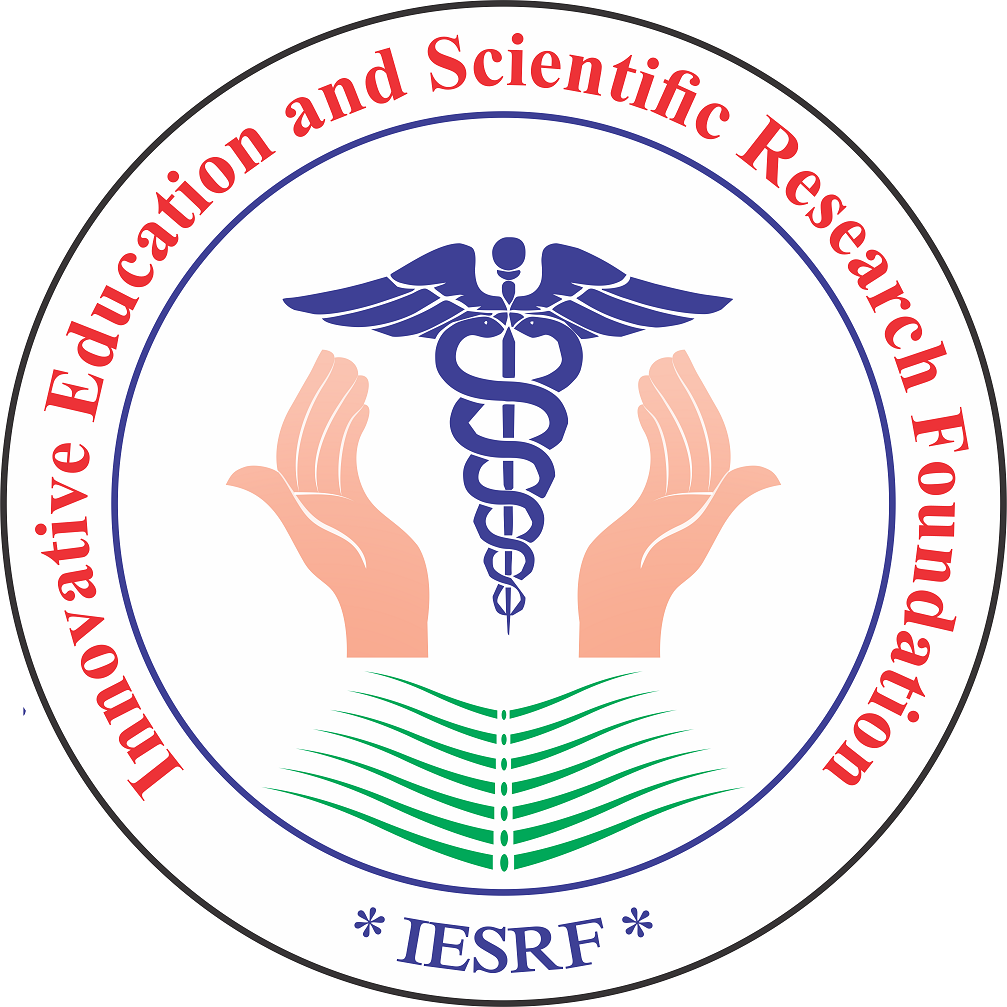- Visibility 1k Views
- Downloads 216 Downloads
- Permissions
- DOI 10.18231/j.jpmhh.2024.015
-
CrossMark
- Citation
Students perceptions & motivation for ‘Basic Pranic Healing workshop’ and its impact on the well-being of medical students
Abstract
Introduction: Pranic Healing (PH) is an ancient energy healing method focusing on the body's energy fields. The study explores its potential positive impact on the well-being of medical students. Existing research supports the transformative effects of PH on molecular structures and overall well-being. Spiritual well-being has been linked to mental health, and the study aims to evaluate the connection between Basic Pranic Healing workshops and students' mental health in a stressful medical school environment.
Materials and Methods: This retrospective observational pilot study recruited 50 medical students through purposive sampling. Participants from Dr. Baba Saheb Ambedkar Medical College, Delhi, India, completed pre and post-workshop questionnaires, assessing knowledge, attitude, interest, motivation, and impact on well-being. Data were analyzed using SPSS, employing descriptive statistics and relevant tests.
Results: 45 interested students participated, with a mean age of 20.78±2.09, 68.8% female. Significant improvements were observed in pre and post-workshop scores for knowledge (p = 0.00), interest (p = 0.00), and confidence (p = 0.00). Beliefs shifted positively with a final favorable perception . Participants reported a positive impact on various life domains with 56% practicing learned techniques weekly. Efficacy in healing (73.4%) and self-healing (84.4%) was notable
Conclusion: The Basic Pranic Healing workshop effectively enhanced participants' knowledge, interest, confidence, beliefs, and overall perceptions. Positive impacts on various life domains and high success rates in healing demonstrate the practical relevance of Pranic Healing in promoting well-being. Findings support the integration of holistic healing practices in healthcare training and personal development programs.
Introduction
The study and practice of pranic healing addresses the energy body which permeates and governs the physical body, mind, and emotions. Research has shown that when pranic healing is used, the molecular structure of liquid and dense states of matter can be considerably changed to produce beneficial results.[1] Pranic healing (PH) is an ancient method which concentrates on the energy fields around and inside the human body. It is a supplementary therapy that doesn't involve touching and relies heavily on the prana or life force to promote healing.[2] Prana is applied to the patient's energy body by the healer. It uses the life energies that are present in the sun, the air, and the ground to heal. The energy body has major, minor, and tiny chakras, much like the physical body contains essential and non-essential organs. The primary chakras or centers govern and energize not only the internal organs but also a person's psychological state. PH helps to manipulate energy field of participants and increase their wellbeing.[3] PH has drawn educated disciples who want to use its therapeutic techniques to enhance their professional and personal development.[4] A number of studies have explored the relationship between spiritual well-being and mental health in students. Hamka (2020) and Jafari (2010) both found a significant positive correlation between the two, with religious and existential well-being being particularly influential.[5], [6] Kharameh (2016) further supported this, highlighting the predictive power of different domains of religious and spiritual well-being on students' mental health.[7] Barmola (2015) also emphasized the potential of religion and spirituality to enhance students' mental health.[8] These findings suggest that practices such as Pranic Healing, which are often associated with spiritual well-being, may have a positive impact on students' mental health.
Medical school is recognized as a stressful environment that often has a negative effect on students’ academic performance, physical health, and psychosocial well-being.[9] According to the study conducted by Sunil D. et al. involving 332 students, the prevalence of depression, anxiety and stress were found to be 124 (37.3%), 168 (50.6%) and 109 (32.8%) respectively.[10] The findings of the study conducted on 42 female undergraduate students of Dev Sanskriti University, Haridwar (Uttarakhand) by Srivastava S. et al. reveal that pranic healing therapy has a significant effect on mental health.[11] Therefore, the study aims to evaluate the student's perceptions and motivation to the Basic Pranic Healing workshop and its impact (if any) on their well being.
Materials and Methods
Study design
This is a retrospective observational pilot study.
Study population
Purposive sampling techniques were employed for recruiting the samples for this study. Based on Inclusion and Exclusion criteria, 50 medical students from all the academic (first to final) years from Dr. Baba Saheb Ambedkar Medical College, Delhi, India who voluntarily enrolled for the pranic healing workshop and were willing to have their data evaluated were recruited for the study. Informed consent was obtained from the participants and their confidentiality was maintained. Students who had history of any chronic physical or psychological ailments were excluded from the analysis.
Study tool
Pre and Post Workshop questionnaire was filled by the participants. It included a Sociodemographic checklist-this was developed to document the participant’s basic information, such as name,gender, age, and year of study. Pre and Post workshop knowledge, attitude, interest, motivation and impact on well being of the participant were recorded using a self designed pre validated questionnaire. History of exposure to prior knowledge or training in Energy healing were also recorded along with their current beliefs regarding pranic healing.
Data collection and analysis
The basic pranic healing training course was conducted by trained professionals.They have recorded data of participants based on the above described study tools. The data is being retrospectively examined and exposed to scientific evaluation. The participants were asked to fill a pre workshop and a post workshop (after 7 days of the workshop) questionnaire. The data was double-checked for accuracy, then coded and entered into Microsoft Excel before being analyzed with the latest SPSS version . The data was analyzed with descriptive statistics such as frequencies, percentages, and central tendency measures with required statistical tests to be applied to test the difference across the groups and p<0.05 was considered statistically significant. The Wilk Shapiro test was used to identify normality of data.
Results
45 participants of mean age±SD: 20.78±2.09 with n=31 (68.8%) female participants. 71.1% (n=32) had no previous exposure to pranic healing while 26.6% (n=12) had some unprofessional exposure while 0.02% (n=1) had basic professional exposure (webinar). Scores of pre and post workshop knowledge, interest and confidence is tabulated in [Table 1]:
|
Variable |
Pre Workshop (Median±IQR) |
Postworkshop (Median±IQR) |
|
Knowledge |
2±1.00 |
4±3.00 |
|
Interest |
3±2.00 |
4±2.50 |
|
Confidence |
2±1.50 |
4±3.00 |
Students beliefs pre and post workshop are plotted in [Figure 1], which showed significant positive outcome on the student perceptions.
Final outlook is represented in pie chart,[Figure 2]
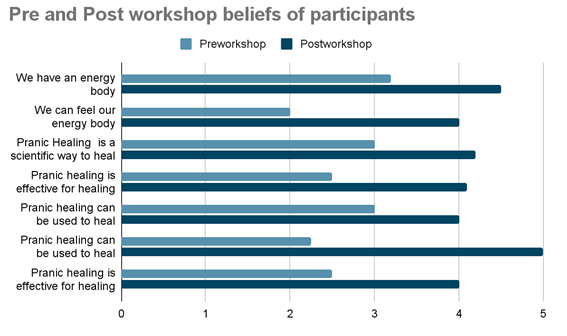
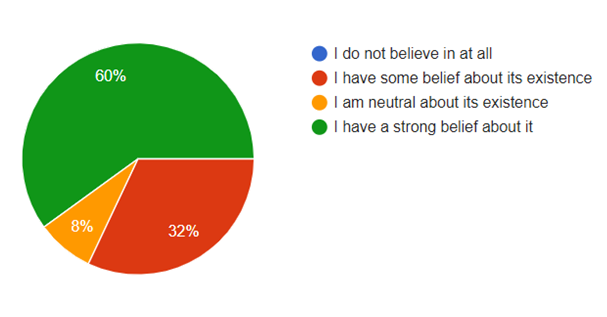
Participants reported the impact pranic healing had on them, on a 1-5 likert scale, which is represented in[Figure 3].
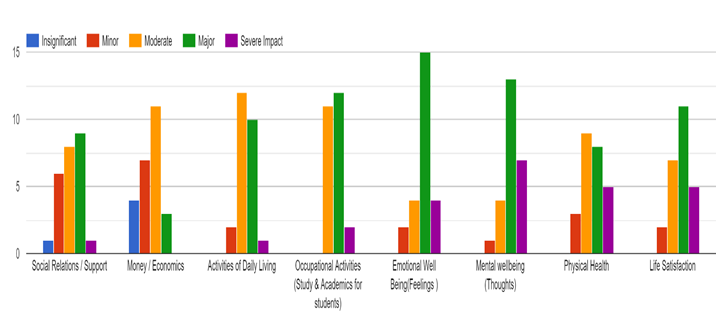
56% of students claimed to practice techniques learnt in the workshop a minimum of once per week, including twin heart meditation (n= 32; 71.1%) and pranic breathing (n= 22; 48.8%) . 84.4% (n=38) students felt that self healing and healing others via PH techniques had some effect. Efficacy based on ailments is plotted in [Figure 4]. The average overall success rate by the cohort of trained students was 73.4% (124 out of 168 patients who they collected attempted to heal over the period of 7 days).
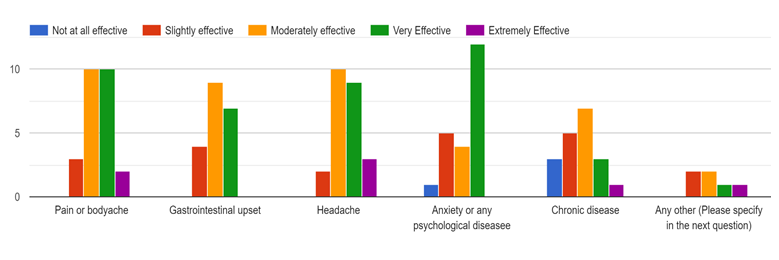
Discussion
The results of the study provide valuable insights into the perceptions, experiences, and outcomes associated with the Basic Pranic Healing workshop. This discussion will comprehensively analyze the key findings, including participant demographics, pre and post-workshop scores, beliefs, the final outlook of perception, reported impact on various life domains, and the efficacy of pranic healing techniques. Our findings are in agreement with literature. From previous studies on the Research on the impact of Basic Pranic Healing Perception after a workshop has shown positive outcomes. Belal (2023) found that participants experienced various sensations, which can benefit their affective and physical state.[12] Singh (2015) reported a significant improvement in chakras and leadership effectiveness among middle-level managers. Jois (2018) demonstrated an increase in the quality of life among working women employees, with a majority experiencing tingling sensations.[13] Jois (2015) further highlighted the positive psychological effects of pranic energy perception, with most participants feeling relaxed and happy.[14] These studies collectively suggest that the Basic Pranic Healing Perception can have a positive impact on individuals' well-being.
The demographic profile of the participants is noteworthy. With 53 students expressing interest and 45 ultimately participating, the workshop attracted a diverse group with a mean age of 20.78±2.09. The majority of participants were female (68.8%), reflecting a gender-balanced interest in pranic healing. It is interesting to note that a significant portion (71.1%) had no prior exposure to pranic healing, indicating the workshop's appeal to those new to the practice.
The pre and post-workshop scores in knowledge, interest, and confidence, as presented in [Table 1], reveal a statistically significant improvement across all three variables. The median scores for knowledge, interest, and confidence all increased from 2 to 4, indicating a substantial positive impact of the workshop. The p-values of 0.00 for each variable underscore the significance of these improvements. This suggests that the Basic Pranic Healing workshop effectively enhanced participants' understanding of pranic healing concepts, increased their interest in the practice, and boosted their confidence in applying pranic healing techniques. Such improvements are crucial in the context of holistic healing practices, as they contribute to a more informed and motivated cohort of individuals. The effectiveness of the Basic Pranic Healing workshop in enhancing participants' understanding of pranic healing concepts is supported by a range of studies. Jois (2018) found that Pranic Healing significantly improved the quality of life of working women employees, while Kearsley (2014) reported transformative learning experiences for medical students through healing workshops.[15], [16] Lama (2020) demonstrated the effectiveness of Pranic Healing in treating insomnia, and Hofer (2002) argued for its introduction in clinical nursing practice.[17] These studies collectively suggest that the Energy Pranic Healing workshop is effective in enhancing participants' understanding of pranic healing concepts and can have a positive impact on their well-being.
The comparison of pre and post-workshop beliefs, as illustrated in [Figure 1], further supports the positive outcomes of the workshop. The shift towards more positive beliefs after the workshop suggests a transformative influence on participants' perspectives. This aligns with the reported impact of pranic healing on various life domains, depicted in [Figure 3]. The dominance of positive perceptions, as indicated by the larger segments, reinforces the overall success of the workshop in shaping a favorable outlook among participants.
The real-world application of pranic healing techniques is a crucial aspect explored in the study. Pranic healing, a non-pharmacological therapy, has shown promising results in various real-world applications. Astuti (2019) demonstrated its effectiveness in reducing emotional stress in pregnant women, while Vinushree (2021) reported its potential as a complementary therapy for managing fibromyalgia symptoms.[17], [18] Wardha (2004) highlighted its ability to alter the molecular structure of matter, and Hofer (2002) advocated for its integration into clinical nursing practice.[19], [20] These studies collectively suggest that pranic healing techniques can be beneficial in promoting emotional well-being and managing chronic pain. In our study, A significant proportion of participants reported practicing the learned techniques regularly, with 56% engaging in practices at least once a week. Twin heart meditation and pranic breathing were among the most commonly practiced techniques, emphasizing their appeal and feasibility for regular incorporation into participants' routines.
Moreover, the reported efficacy of self-healing and healing others through pranic healing techniques is substantial, with 84.4% of participants acknowledging some positive effects. The success rates, as depicted in [Figure 4], highlight the practical utility of pranic healing in addressing various ailments. The average overall success rate of 73.4% is promising, showcasing the potential of pranic healing techniques when applied by trained individuals.
While the study provides valuable insights, certain limitations should be considered. The sample size, although indicative, may not be fully representative of broader populations. Additionally, self-reported data on the impact of pranic healing is subjective and might be influenced by individual perceptions.
Conclusion
In conclusion, the Basic Pranic Healing workshop demonstrated its efficacy in positively influencing participants' knowledge, interest, confidence, beliefs, and overall perceptions. The reported impact on various life domains, regular practice of learned techniques, and high success rates in healing further validate the practical relevance of pranic healing in enhancing well-being. These findings contribute to the growing body of evidence supporting the integration of holistic healing practices like pranic healing into training of healthcare professionals and various other personal development programs. The study highlights the potential of pranic healing to empower individuals with effective tools for self-care and healing.
Source of Funding
None.
Conflict of Interest
None.
References
- Wardha H. Pranic healing. Aust J Holist Nurs. 2004;11(2):35-40. [Google Scholar]
- Rajagopal R, Jois S, Majgi M, Shashidhar M, Kumar A. Amelioration of mild and moderate depression through Pranic Healing as adjuvant therapy: randomised double-blind controlled trial. Aust Psychiatry. 2018;26(1):82-7. [Google Scholar]
- Tsuchiya K, Motoyama H. Study of body’s energy changes in non-touch energy healing Pranic Healing protocol applied for a breast cancer subject. SEEMJ. 2009;20:15-29. [Google Scholar]
- Jauregui M, Schuster T, Clark M. Pranic Healing: Documenting Use, Expectations, and Perceived Benefits of a Little-Known Therapy in the United States. J Sci Expl. 2012;26(3):569-88. [Google Scholar]
- Hamka, Matuzahroh N, Mein-Woei S. Spiritual Well-Being and Mental Health of Students in Indonesia. Adv Soc Sci Educ Hum Res. 2020;395:149-52. [Google Scholar]
- Jafari E, Dehshiri G, Eskandari H, Najafi M, Heshmati R, Hoseinifar J. Spiritual well-being and mental health in university students. Procedia - Soc Behav Sci. 2010;5:1477-81. [Google Scholar]
- Kharameh Z, Sharififard F, Alizadeh M, Vahidabi V, Mirhoseini H, Omidi R. An Investigation of the Relationship between Spiritual-Religious Well-Being and Mental Health in Students. Qom Univ Med Sci J. 2016;10:102-9. [Google Scholar]
- Barmola K. Religion/Spirituality and Mental Health of Students. J Environ Soc Sci. 2015;2(1):1-3. [Google Scholar]
- Saravanan C, Wilks R. Medical Students’ Experience of and Reaction to Stress: The Role of Depression and Anxiety. The Sci World J. 2014;29:1-8. [Google Scholar]
- Kumar S, Kavitha H, Kulkarni P. Depression, anxiety and stress levels among medical students in Mysore. Int J Commun Med Public Health. 2016;3(1):359-62. [Google Scholar]
- Rajagopal R, Majgi S, Kumar MA, Shashidhar H. Effectiveness of Pranic Healing on Mental Health. J Psychos Res. 2019;14:171-6. [Google Scholar]
- Belal M, Mallikarjunappa M, Nagaraj S, Salagame K, Jois S. Understanding Pranic Energy Experiences: A Qualitative Approach. . Adv Mind-body Med. 2023;37(1):22-7. [Google Scholar]
- Jois S, Souza L, Prasad K, Manasa B. Enhancement of Quality of Life through Pranic Healing among Working Women Employees. J Psychol Educ Res. 2018;26(1):147-57. [Google Scholar]
- Jois S, Aithal R, Souza L, Gayatri R. The perception of prana and its effect on psychological well being. J Res Bede ATHENÆUM. 2015;6:210-5. [Google Scholar]
- Jois S, Souza L, Prasad K, Manasa B. Enhancement of Quality of Life through Pranic Healing among Working Women Employees. J Psychol Educ Res. 2018;26(1):147-57. [Google Scholar]
- Kearsley J, Lobb E. ‘Workshops in healing’ for senior medical students: a 5-year overview and appraisal. Med Hum. 2014;40(2):73-9. [Google Scholar]
- Astuti C, Widyawati M, Suryono S. Application Model of Pranic Healing Therapy for Emotional Stress Using Accurate Bio-Well GDV Camera. E3S Web Conference. 2019;125(1). [Google Scholar]
- Vinushree M. Pranic Healing as a Complementary Therapy in Managing Fibromyalgia: A Case Report. J Clin Diagn Res. 2021;15(9):1-2. [Google Scholar]
- Wardha H. Pranic healing. The Australian journal of holistic nursing. Aust J Holis Nurs. 2004;11(2):35-40. [Google Scholar]
- Hofer W, Bruni N. Pranic healing: an energy-based healing practice for the contemporary nurse.. Aust J Holistic Nurs. 2002;9(1):22-32. [Google Scholar]
How to Cite This Article
Vancouver
Renjhen P, Kumar P, Abhishek K, Jha RP. Students perceptions & motivation for ‘Basic Pranic Healing workshop’ and its impact on the well-being of medical students [Internet]. J Prev Med Holist Health. 2024 [cited 2025 Oct 11];10(2):61-65. Available from: https://doi.org/10.18231/j.jpmhh.2024.015
APA
Renjhen, P., Kumar, P., Abhishek, K., Jha, R. P. (2024). Students perceptions & motivation for ‘Basic Pranic Healing workshop’ and its impact on the well-being of medical students. J Prev Med Holist Health, 10(2), 61-65. https://doi.org/10.18231/j.jpmhh.2024.015
MLA
Renjhen, Prachi, Kumar, Pratyush, Abhishek, Kumar, Jha, Ravi Prakash. "Students perceptions & motivation for ‘Basic Pranic Healing workshop’ and its impact on the well-being of medical students." J Prev Med Holist Health, vol. 10, no. 2, 2024, pp. 61-65. https://doi.org/10.18231/j.jpmhh.2024.015
Chicago
Renjhen, P., Kumar, P., Abhishek, K., Jha, R. P.. "Students perceptions & motivation for ‘Basic Pranic Healing workshop’ and its impact on the well-being of medical students." J Prev Med Holist Health 10, no. 2 (2024): 61-65. https://doi.org/10.18231/j.jpmhh.2024.015
